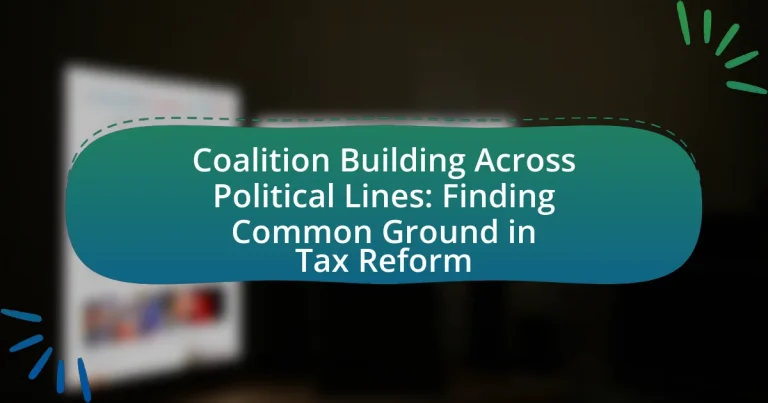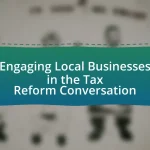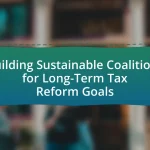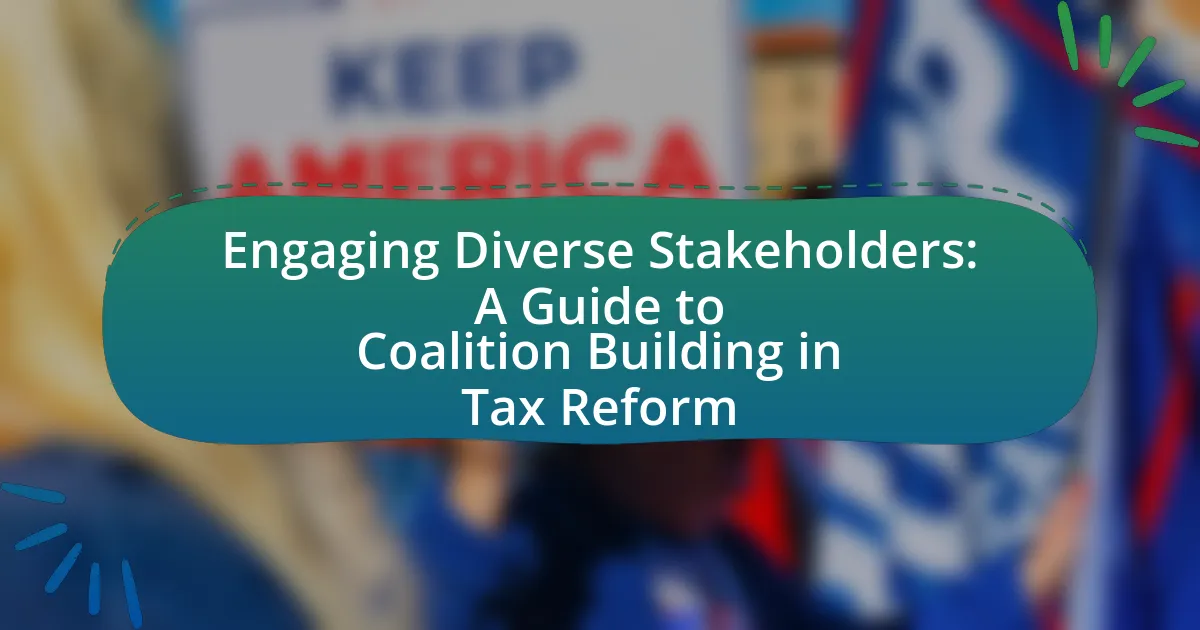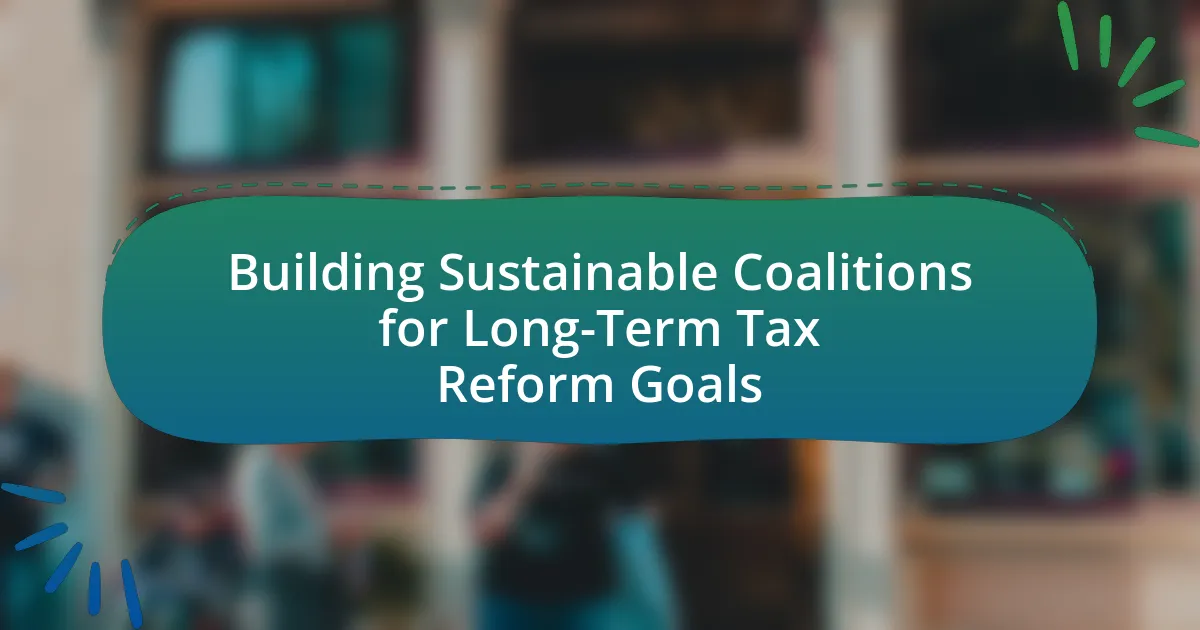Coalition building across political lines in tax reform involves strategic collaboration among diverse political groups to achieve shared objectives in tax policy changes. This article examines the significance of coalition building, highlighting historical examples such as the Tax Reform Act of 1986 and the Tax Cuts and Jobs Act of 2017, which demonstrate the potential for bipartisan cooperation. It discusses the challenges faced by coalitions, including differing political ideologies and priorities, and emphasizes the role of public opinion and negotiation techniques in fostering effective collaboration. Additionally, the article outlines practical steps advocates can take to promote coalition building, ultimately underscoring the implications of successful coalitions for sustainable tax reform and governance.
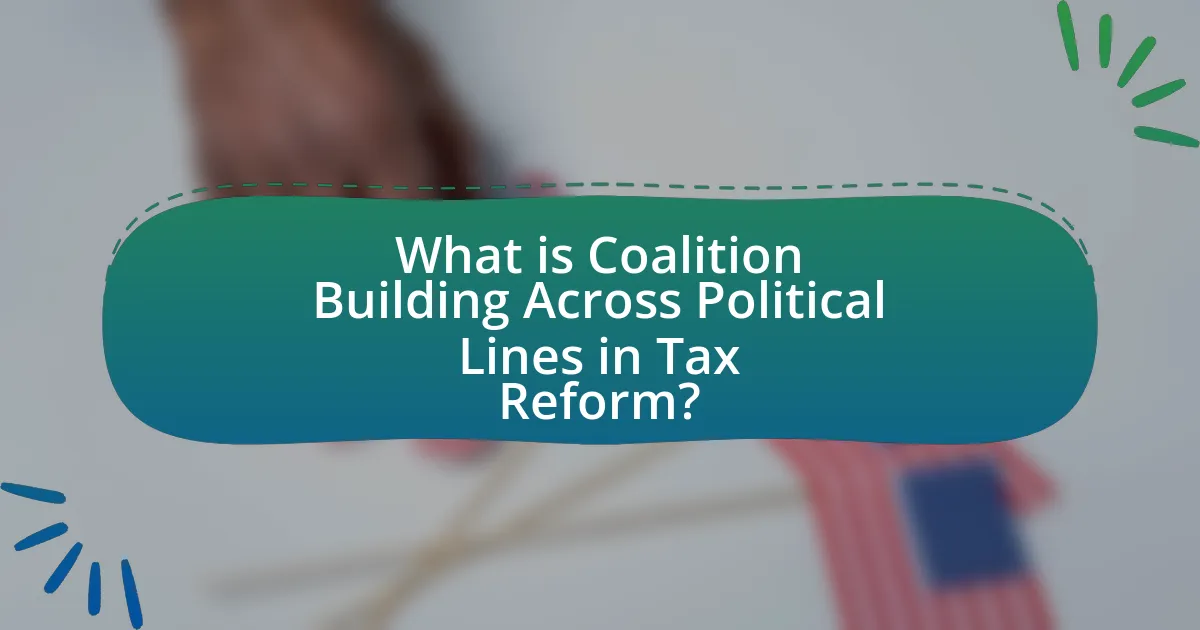
What is Coalition Building Across Political Lines in Tax Reform?
Coalition building across political lines in tax reform refers to the strategic collaboration between diverse political groups to achieve common goals in tax policy changes. This approach often involves identifying shared interests, such as economic growth or fairness in taxation, which can unite parties that typically have opposing views. Historical examples include bipartisan efforts in the Tax Reform Act of 1986, where Democrats and Republicans worked together to simplify the tax code and lower rates, demonstrating that cross-party alliances can lead to significant legislative outcomes.
Why is coalition building important in tax reform discussions?
Coalition building is important in tax reform discussions because it fosters collaboration among diverse stakeholders, leading to more comprehensive and effective policy solutions. By uniting various interest groups, including businesses, advocacy organizations, and political parties, coalition building enhances the legitimacy and acceptance of tax reforms. Historical examples, such as the bipartisan support for the Tax Reform Act of 1986, demonstrate that successful tax reforms often emerge from coalitions that bridge ideological divides, ensuring broader representation and addressing the concerns of multiple constituencies. This collaborative approach not only increases the likelihood of passing reforms but also promotes stability and sustainability in tax policy.
What are the historical examples of successful coalitions in tax reform?
Historical examples of successful coalitions in tax reform include the Tax Reform Act of 1986 in the United States, which was a bipartisan effort led by President Ronald Reagan and Democratic House Speaker Tip O’Neill. This coalition resulted in significant changes to the tax code, lowering tax rates and broadening the tax base, ultimately simplifying the tax system. Another example is the 2017 Tax Cuts and Jobs Act, where Republicans united with some Democrats to pass tax cuts, showcasing cross-party collaboration despite significant partisan divides. These instances demonstrate how coalitions can effectively navigate political differences to achieve comprehensive tax reform.
How do political ideologies influence coalition building?
Political ideologies significantly influence coalition building by shaping the values, priorities, and policy preferences of the parties involved. For instance, parties with similar ideological beliefs, such as those on the left advocating for social equity, are more likely to collaborate on tax reform initiatives aimed at wealth redistribution. Conversely, parties on the right, which prioritize free-market principles, may seek coalitions focused on tax cuts and deregulation. Historical examples, such as the bipartisan efforts during the Tax Reform Act of 1986 in the United States, illustrate how ideological alignment can facilitate cooperation across party lines, leading to comprehensive tax reforms that reflect a blend of differing perspectives.
What challenges do coalitions face in tax reform?
Coalitions face significant challenges in tax reform, primarily due to differing political ideologies and priorities among members. These ideological differences can lead to conflicts over the goals of tax reform, such as whether to prioritize revenue generation, equity, or economic growth. Additionally, coalitions often struggle with the need to balance the interests of diverse stakeholders, which can complicate consensus-building. For instance, a coalition may include both business interests advocating for lower corporate taxes and social equity groups pushing for higher taxes on the wealthy, creating inherent tensions. Furthermore, the complexity of tax systems and the technical nature of tax policy can hinder effective communication and understanding among coalition members, making it difficult to reach agreement on specific proposals.
How do differing priorities among political parties affect coalition efforts?
Differing priorities among political parties significantly hinder coalition efforts by creating obstacles in reaching consensus on policy objectives. When parties prioritize divergent issues, such as economic growth versus social equity, they struggle to align their agendas, which complicates negotiations. For instance, during the 2010-2011 budget negotiations in the United States, the stark differences between Republican priorities focused on tax cuts and Democratic priorities centered on social programs led to prolonged stalemates and ultimately affected the ability to form effective coalitions. This illustrates that when parties cannot find common ground on their core priorities, coalition-building becomes increasingly challenging, often resulting in gridlock or ineffective governance.
What role does public opinion play in coalition dynamics?
Public opinion significantly influences coalition dynamics by shaping the priorities and strategies of political actors. When public sentiment favors specific policies, such as tax reform, coalition partners are more likely to align their agendas to reflect these preferences, thereby enhancing their chances of electoral success. For instance, research indicates that coalitions formed in response to strong public support for tax reform initiatives tend to be more stable and effective, as seen in various legislative contexts where public backing has led to successful bipartisan agreements. This alignment with public opinion not only legitimizes the coalition’s actions but also helps maintain its cohesion, as members are motivated to respond to the electorate’s demands.
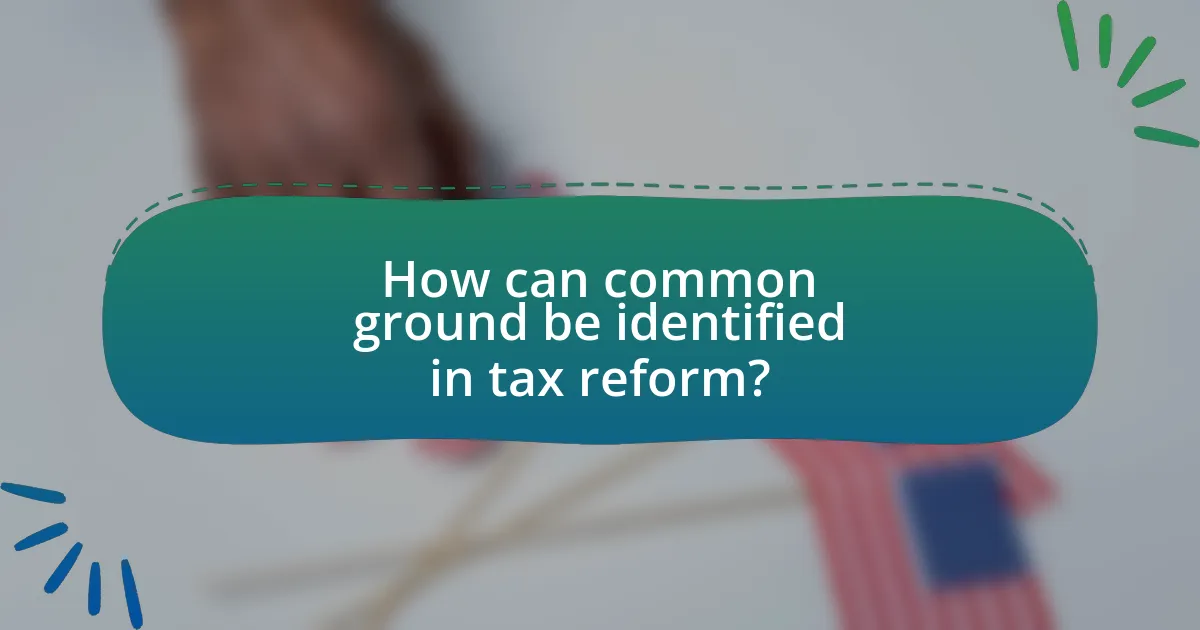
How can common ground be identified in tax reform?
Common ground in tax reform can be identified through collaborative dialogue among stakeholders, including policymakers, economists, and the public. This process involves assessing shared goals, such as economic growth, fairness, and simplicity in the tax system. For instance, studies have shown that bipartisan support often emerges around tax policies that promote job creation and equitable tax burdens, as evidenced by the Tax Reform Act of 1986, which garnered support from both parties by focusing on broadening the tax base while lowering rates. Engaging in transparent discussions and utilizing data-driven analyses can further highlight areas of agreement, facilitating the development of tax reforms that are acceptable across political lines.
What strategies can be employed to find common ground?
To find common ground in tax reform, stakeholders can employ strategies such as active listening, identifying shared values, and fostering open dialogue. Active listening allows participants to understand differing perspectives, which is crucial in a politically charged environment. Identifying shared values, such as economic growth or fairness, helps to create a foundation for collaboration. Fostering open dialogue encourages transparency and trust, enabling parties to discuss their concerns and priorities without hostility. Research indicates that these strategies can lead to more effective coalition building, as evidenced by successful bipartisan efforts in past tax reforms, such as the Tax Reform Act of 1986, which involved extensive negotiation and compromise among diverse political groups.
How do negotiation techniques facilitate coalition building?
Negotiation techniques facilitate coalition building by enabling diverse stakeholders to identify shared interests and establish mutual agreements. Techniques such as active listening, framing issues collaboratively, and employing integrative bargaining allow parties to communicate effectively, fostering trust and understanding. For instance, in tax reform discussions, negotiators can use these techniques to highlight common goals, such as economic growth or equitable tax distribution, which can unite different political factions. Research indicates that successful coalitions often emerge when negotiators focus on interests rather than positions, as demonstrated in the bipartisan efforts during the 2017 tax reform debates, where stakeholders from various political backgrounds collaborated to achieve a common legislative outcome.
What role does compromise play in achieving tax reform goals?
Compromise is essential in achieving tax reform goals as it facilitates collaboration among diverse political factions. By finding common ground, lawmakers can create a balanced tax policy that addresses the interests of various stakeholders, including taxpayers, businesses, and government entities. Historical examples, such as the Tax Reform Act of 1986, illustrate how bipartisan negotiations led to significant changes in the tax code, demonstrating that compromise can yield effective and sustainable reforms.
What are the key issues that unite different political factions in tax reform?
Key issues that unite different political factions in tax reform include the need for simplification of the tax code, the desire to close tax loopholes, and the aim to ensure fairness in the tax system. Simplifying the tax code can reduce compliance costs and make it easier for individuals and businesses to understand their tax obligations, which is a common goal across the political spectrum. Closing tax loopholes is often seen as a way to increase revenue without raising tax rates, appealing to both fiscal conservatives and progressives who advocate for equity. Ensuring fairness in the tax system resonates with various factions, as it addresses concerns about the disproportionate burden on lower-income individuals compared to wealthier taxpayers. These shared objectives create a foundation for coalition building in tax reform efforts.
How can economic data be used to bridge gaps between parties?
Economic data can bridge gaps between parties by providing objective evidence that informs discussions and decisions. For instance, data on tax revenue impacts can illustrate how proposed reforms affect different income groups, fostering understanding and collaboration. Historical examples, such as the bipartisan support for the Tax Reform Act of 1986, demonstrate that when parties rely on shared economic metrics, they can identify mutual benefits and align their interests. This reliance on data helps to reduce ideological divides by focusing on measurable outcomes rather than partisan rhetoric.
What specific tax reform proposals have garnered bipartisan support?
Specific tax reform proposals that have garnered bipartisan support include the Tax Cuts and Jobs Act of 2017, which aimed to lower corporate tax rates and simplify the tax code, and the Earned Income Tax Credit (EITC) expansion, which has received backing from both parties for its effectiveness in reducing poverty. Additionally, proposals to enhance tax incentives for renewable energy investments have also seen bipartisan agreement, reflecting a shared interest in promoting sustainable practices while stimulating economic growth. These examples illustrate a willingness among lawmakers to collaborate on tax reforms that address economic challenges and benefit a broad range of constituents.
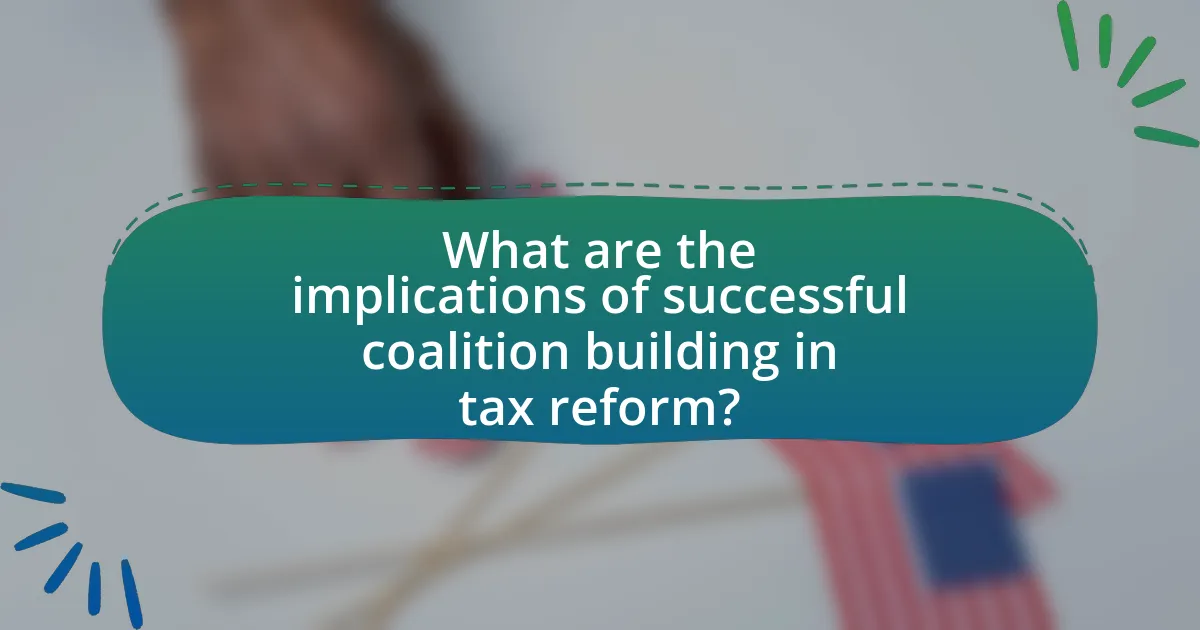
What are the implications of successful coalition building in tax reform?
Successful coalition building in tax reform leads to more comprehensive and sustainable policy changes. When diverse stakeholders, including political parties, interest groups, and the public, unite, they create a broader base of support that enhances the legitimacy and acceptance of tax reforms. Historical examples, such as the Tax Reform Act of 1986 in the United States, demonstrate that bipartisan cooperation can result in significant changes that address various economic concerns while minimizing opposition. This collaborative approach often leads to more equitable tax systems, as it incorporates multiple perspectives and needs, ultimately fostering greater public trust in government institutions.
How does successful coalition building impact policy outcomes?
Successful coalition building significantly enhances policy outcomes by fostering collaboration among diverse stakeholders, which leads to more comprehensive and widely accepted policies. When various interest groups, including political parties, advocacy organizations, and community leaders, unite around shared goals, they can leverage their collective influence to advocate for specific policy changes. For instance, in tax reform discussions, coalitions that include both progressive and conservative voices can create balanced proposals that address the concerns of multiple constituencies, increasing the likelihood of bipartisan support. Research indicates that policies developed through coalitions are often more effective and sustainable, as they reflect a broader range of perspectives and interests, ultimately resulting in higher public approval and successful implementation.
What are the long-term effects of bipartisan tax reform on governance?
Bipartisan tax reform can lead to increased stability and predictability in governance. This stability arises from the collaborative nature of bipartisan efforts, which often result in more comprehensive and widely accepted tax policies. For instance, the Tax Reform Act of 1986, which was a bipartisan effort, created a simpler tax code and reduced rates, leading to sustained economic growth and increased compliance. Additionally, bipartisan tax reforms can foster a culture of cooperation among political parties, encouraging future collaborations on other governance issues. This cooperative environment can enhance public trust in government, as citizens perceive their leaders as capable of working together for the common good.
How can successful coalitions influence future political collaborations?
Successful coalitions can significantly influence future political collaborations by establishing a precedent for cooperation and demonstrating the effectiveness of collective action. When coalitions achieve tangible results, such as passing legislation or implementing policy changes, they create a model that other political entities may seek to replicate. For instance, the bipartisan coalition that successfully passed the Tax Cuts and Jobs Act in 2017 showcased how diverse political groups can unite around common goals, thereby encouraging future collaborations on tax reform and other issues. This historical example illustrates that successful coalitions not only achieve immediate objectives but also foster an environment conducive to ongoing political partnerships.
What lessons can be learned from past coalition efforts in tax reform?
Past coalition efforts in tax reform demonstrate the importance of compromise and stakeholder engagement. Successful coalitions often included diverse political perspectives, which facilitated broader acceptance of tax reforms. For instance, the Tax Reform Act of 1986, which garnered bipartisan support, highlighted that aligning interests among various groups can lead to effective policy changes. Additionally, clear communication and transparency throughout the process were crucial in building trust and ensuring that all parties felt represented. These lessons underscore that inclusive dialogue and a willingness to negotiate are essential for achieving lasting tax reform.
What best practices can be identified from successful coalitions?
Successful coalitions often implement best practices such as establishing clear goals, fostering open communication, and building trust among members. Clear goals ensure that all coalition members are aligned in their objectives, which is crucial for maintaining focus and direction. Open communication facilitates transparency and encourages the sharing of ideas, which can lead to innovative solutions. Building trust among coalition members enhances collaboration and commitment, as evidenced by the success of coalitions like the bipartisan “Fix the Debt” campaign, which effectively united diverse stakeholders around a common fiscal responsibility agenda. These practices are essential for navigating the complexities of coalition building, particularly in politically charged environments like tax reform.
How can failures in coalition building inform future strategies?
Failures in coalition building can inform future strategies by highlighting the importance of understanding diverse stakeholder interests and improving communication. Analyzing past failures, such as the inability to unite various political factions during tax reform discussions, reveals that misalignment of goals and lack of trust can hinder collaboration. For instance, the 2017 tax reform efforts in the United States faced significant challenges due to conflicting priorities among Republicans and Democrats, which ultimately led to a fragmented approach. By studying these failures, future strategies can be developed that prioritize inclusive dialogue, establish clear common objectives, and foster relationships built on trust, thereby increasing the likelihood of successful coalition formation.
What practical steps can advocates take to foster coalition building in tax reform?
Advocates can foster coalition building in tax reform by identifying shared goals among diverse stakeholders. This involves conducting stakeholder mapping to understand interests and concerns, facilitating open dialogues to build trust, and creating inclusive platforms for collaboration. For instance, successful coalitions often emerge from joint workshops or forums where participants can express their views and negotiate compromises. Research shows that coalitions with clear, common objectives are more effective; a study by the Brookings Institution highlights that bipartisan efforts in tax reform have historically led to more sustainable policy outcomes.
